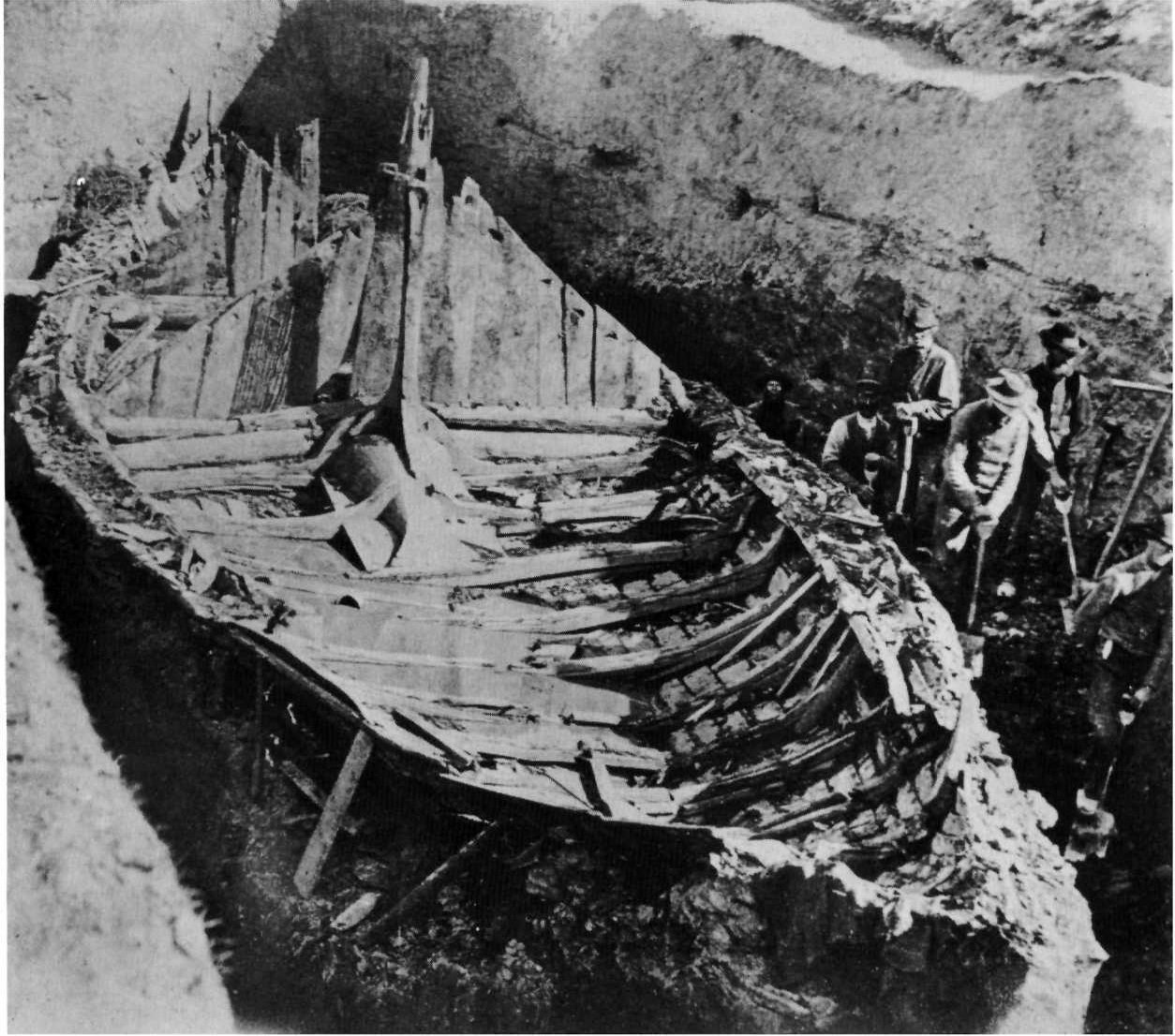Viking Longships: Fearless Dragonships Daring The Oceans And Seas
Ellen Lloyd - AncientPages.com - The Vikings were the lords of the oceans. One of the main reasons behind the Vikings' success in reaching distant lands lies in their remarkable longships. The Vikings’ ships were the European Dark Ages' greatest technical and artistic achievement. Without these great ships, the Viking Age would never have happened.
Viking warrior with a sword standing near Drakkar on the seashore. Credit: Adobe Stock - Nejron Photo
During the Viking era, there were different classes of ships. The longships were mainly used as warships, and the ships called Knarrs (or knorrs in Old Norse) served as slower passenger and cargo ships.
Viking longships were fast and could sail in shallow water. This gave the Vikings the possibility to travel up rivers as well as across the sea. In a raid, a ship could be hauled up on a beach. To surprise your enemy was an important strategic military tactic that gave the Vikings several advantages. The Vikings could jump out, start fighting, and then quickly get away if they were chased.
Many Viking ships were equipped with a dragon head on the bow. The dragon was one of the most famous symbols of the Vikings. Vikings believed the dragon could protect them against evil spirits at sea.
Vikings built their ships beside a river or an inlet of the sea. A tall oak tree was cut to make the keel. The hull of the ships was made of overlapping planks and secured with iron rivets. This made the ships very strong. A wool string was dipped in tar and forced between the planks to prevent leaks.
One man worked a big steering oar at the back end, or stern, to steer the ship.
A Viking ship with a dragon head. Credit: Adobe Stock - mastclick
Dragonships were large longships with carved heads of dragons and other magical beings mounted on their stem. They were ships for chieftains and kings. The ship’s dragonhead was a visual message about the owner’s status.
His dragon with her sails of blue,
All bright and brilliant to the view,
High hoisted on the yard arms wide,
Carries great Canute o’er the tide.
Brave is the royal progress — fast
The proud ship’s keel obeys the mast,
Dashes through foam, and gains the land,
Raising a surge on Limfjord’s strand. (The Song of Canute, Saga of St. Olaf)
"The dragonhead should scare away enemies. It also had magical functions: It would provide protection for ships and crew – and it should ward off evil spirits both on land and sea. The Icelandic law code Grágás says that the dragonhead should be taken off the ship when the Vikings returned to their homestead, not to intimidate the spirits of their native land. (Grágás was used from about 930 and written down about 1117)
The dragonhead made it easy to recognize a certain ship. It clearly shows who the leader is and where the leader is in battle. The symbolic function of the dragonhead is enhanced by the fact that ships often were named after the magical animal that graced its prow."1
A dragon ship was usually between 30-50 meters long and could carry 40 and 60 oarsmen. The men slept and ate on the deck. There was some space below the deck for stores but no cabins. Two of the most famous Viking Ships, the Gokstad Viking ship, and the Oseberg ship, were found by archaeologists in Norway.
Both ships were buried in Viking funerals between AD 800 and 900 and are now in the Viking Ship Museum in Oslo, Norway.
It was in a longship that Leif Eriksson landed on the American coast around the year 1000, long before Columbus. Of course, all other famous Viking warriors used longships when they traveled to other countries.
The longships were more or less invincible and gave the Vikings a vital advantage when they went to war or raids.
Updated on January 17, 2024
Written by – Ellen Lloyd - AncientPages.com
Copyright © AncientPages.com All rights reserved. This material may not be published, broadcast, rewritten or redistributed in whole or part without the express written permission of AncientPages.com
Expand for referencesMore From Ancient Pages
-
 How Did People Go To The Toilet In The Past Before The Invention Of The Flush Toilet?
Archaeology | Jun 10, 2023
How Did People Go To The Toilet In The Past Before The Invention Of The Flush Toilet?
Archaeology | Jun 10, 2023 -
 Shepherd’s Graffiti Sheds New Light On Acropolis Lost Temple Mystery – New Research
Featured Stories | Jun 17, 2024
Shepherd’s Graffiti Sheds New Light On Acropolis Lost Temple Mystery – New Research
Featured Stories | Jun 17, 2024 -
 3,000-Year-Old Nimrud Lens Could Re-Write The History Of Science – Was The World’s Oldest Telescope Developed By Ancient Assyrian Astronomers?
Ancient Technology | Oct 19, 2014
3,000-Year-Old Nimrud Lens Could Re-Write The History Of Science – Was The World’s Oldest Telescope Developed By Ancient Assyrian Astronomers?
Ancient Technology | Oct 19, 2014 -
 Sobek: A 2,500-Year-Old Mummified Nile Crocodile – On Display At The British Museum
Archaeology | Dec 9, 2015
Sobek: A 2,500-Year-Old Mummified Nile Crocodile – On Display At The British Museum
Archaeology | Dec 9, 2015 -
 Ancient Egyptian Village That Is Far Predating Egypt’s Oldest Known Pyramid – Discovered
Archaeology | Sep 3, 2018
Ancient Egyptian Village That Is Far Predating Egypt’s Oldest Known Pyramid – Discovered
Archaeology | Sep 3, 2018 -
 Aboriginal Art And Knowledge Unlocks Mystery Of Fairy Circles
Archaeology | Apr 5, 2023
Aboriginal Art And Knowledge Unlocks Mystery Of Fairy Circles
Archaeology | Apr 5, 2023 -
 Something Unexpected Stopped Mongol Hordes From Conquering Europe
Featured Stories | Jul 11, 2017
Something Unexpected Stopped Mongol Hordes From Conquering Europe
Featured Stories | Jul 11, 2017 -
 Pythagorean Cup Was A Practical Joke To Punish Greedy Drinkers And It Still Fools People
Ancient History Facts | Dec 18, 2020
Pythagorean Cup Was A Practical Joke To Punish Greedy Drinkers And It Still Fools People
Ancient History Facts | Dec 18, 2020 -
 Young Boy Finds A Huge Tooth From A Prehistoric Shark In South Carolina
Archaeology | Sep 3, 2022
Young Boy Finds A Huge Tooth From A Prehistoric Shark In South Carolina
Archaeology | Sep 3, 2022 -
 Five Ancient Mirror Frames, Ceramics Factory Found In Intriguing Roman Villa In Pavlikeni, Bulgaria
Archaeology | Mar 13, 2018
Five Ancient Mirror Frames, Ceramics Factory Found In Intriguing Roman Villa In Pavlikeni, Bulgaria
Archaeology | Mar 13, 2018 -
 Can Pollen Analysis Solve The Ice Age Mystery How And When Homo Sapiens Migrated Across Europe And Asia?
Archaeology | Sep 23, 2023
Can Pollen Analysis Solve The Ice Age Mystery How And When Homo Sapiens Migrated Across Europe And Asia?
Archaeology | Sep 23, 2023 -
 Ancient DNA Of Segorbe Giant Reveals A Brutal Event In Medieval Spain
News | Sep 26, 2021
Ancient DNA Of Segorbe Giant Reveals A Brutal Event In Medieval Spain
News | Sep 26, 2021 -
 Did The Biblical Magi Bring Jesus Gifts With Healing Properties?
Biblical Mysteries | Dec 24, 2017
Did The Biblical Magi Bring Jesus Gifts With Healing Properties?
Biblical Mysteries | Dec 24, 2017 -
 Frightening Edinburgh Vaults: The Spooky Underground City Of The Dead
Featured Stories | Jun 4, 2016
Frightening Edinburgh Vaults: The Spooky Underground City Of The Dead
Featured Stories | Jun 4, 2016 -
 Does A Baffling Artifact Offer Evidence Of Ancient Extraterrestrial Visitation In New Zealand? – Experts Investigate – Part 2
Ancient Mysteries | Jul 23, 2020
Does A Baffling Artifact Offer Evidence Of Ancient Extraterrestrial Visitation In New Zealand? – Experts Investigate – Part 2
Ancient Mysteries | Jul 23, 2020 -
 Unique 1,600-Year-Old Gold Bead Found By Teenager In Jerusalem’s City Of David
Archaeology | Feb 9, 2023
Unique 1,600-Year-Old Gold Bead Found By Teenager In Jerusalem’s City Of David
Archaeology | Feb 9, 2023 -
 What 12 Ancient Skeletons Discovered In A Mysterious Tomb In Petra Could Tell Us About The Ancient City
Featured Stories | Oct 25, 2024
What 12 Ancient Skeletons Discovered In A Mysterious Tomb In Petra Could Tell Us About The Ancient City
Featured Stories | Oct 25, 2024 -
 Imago Mundi: Famous Babylonian World Map Is The Earliest Known In The World
Artifacts | Sep 10, 2015
Imago Mundi: Famous Babylonian World Map Is The Earliest Known In The World
Artifacts | Sep 10, 2015 -
 Nicholas Roerich’s Search For Shambhala And Wish To Fulfill The Mysterious Buddhist Prophecy
Ancient Mysteries | Nov 4, 2016
Nicholas Roerich’s Search For Shambhala And Wish To Fulfill The Mysterious Buddhist Prophecy
Ancient Mysteries | Nov 4, 2016 -
 Large Pre-Columbian Pyramid Discovered Under Highway In Mexico But It Will Not Be Excavated
Archaeology | Dec 16, 2024
Large Pre-Columbian Pyramid Discovered Under Highway In Mexico But It Will Not Be Excavated
Archaeology | Dec 16, 2024



